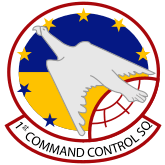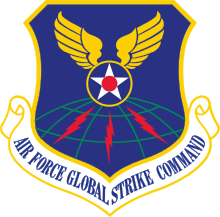1st Airborne Command Control Squadron
| 1st Airborne Command Control Squadron | |
|---|---|
 1st Airborne Command and Control Squadron Boeing E-4 in flight | |
| Active | 1917-1922; 1929-1942; 1942-1944; 1969-present |
| Country |
|
| Branch |
|
| Role | Airborne Command and Control |
| Part of | Air Force Global Strike Command |
| Garrison/HQ | Offutt Air Force Base |
| Engagements | Western Front (World War I)[1] |
| Decorations |
Air Force Meritorious Unit Award Air Force Outstanding Unit Award[1] |
| Insignia | |
| 1st Airborne Command Control Squadron emblem (approved 8 August 1969)[1] |
 |
The 1st Airborne Command Control Squadron is part of the 595th Command and Control Group at Offutt Air Force Base, Nebraska. It operates the Boeing E-4 aircraft conducting airborne command and control missions.
The squadron is one of the oldest in the United States Air Force, its origins dating to 25 September 1917, when it was organized at Fort Omaha, Nebraska. It served overseas in France as part of the American Expeditionary Forces during World War I. The squadron saw combat during World War II, and became part of the Strategic Air Command during the Cold War.
History
World War and Balloon School
The first predecessor of the squadron was organized at Fort Omaha Nebraska in September 1917 as Company A, 2d Balloon Squadron. Two months later it departed for overseas service on the Western Front (World War I), arriving in France in January 1918. It entered combat as an observation unit with the French Eighth Army on 19 April 1918, operating observation balloons over the front lines. Once forces of the American Expeditionary Forces, had built up, it continued to operate as the 1st Balloon Company with the American I Corps until 17 October 1918. Following the end of the war, it served with III Corps as part of the occupation forces until April 1919.[1]
Interwar years
In the spring of 1919, the squadron returned to the United States and was stationed at Ross Field, California as part of the Air Service Balloon School.[1] In June 1922, the Balloon School moved to Scott Field, Illinois and Ross Field was closed as a military installation. The squadron was inactivated[1] with the colosure of Ross.
The second predecessor of the squadron, also designated the 1st Balloon Company, was activated at Scott in May 1929. After a brief period of training with the 21st Airship Group at Scott, it moved to Post Field, located on Fort Sill, Oklahoma, where it was assigned to the Field Artillery School.[1] It trained and conducted exercises with the school. At the beginning of World War II, it operated barrage balloons, but that mission was assigned to the coast artillery and the squadron was disbanded two months after the Japanese attack on Pearl Harbor.
World War II
The third predecessor of the squadron was activated in April 1942 at Long Beach Army Air Base as the 1st Air Corps Ferrying Squadron, the location of a Douglas Aircraft Company manufacturing plant. It ferried aircraft from the Douglas factory and othe factories in the Western Procurement District to overseas departure points.[1] However, the Army Air Forces was finding that standard military units, based on relatively inflexible tables of organization were not well adapted to the training and logistics support mission. Accordingly it adopted a more functional system in which each base was organized into a separate numbered unit.[2] In March 1944, Air Transport Command units assigned to the 6th Ferrying Group were combined into the 556th AAF Base Unit.
Airborne command and control
On 1 June 1962, Headquarters Command organized the 1000th Airborne Command Control Squadron at Andrews Air Force Base to operate the National Emergency Airborne Command Post and assigned it to the 1001st Air Base Wing.[3][4] By 1965, the squadron was operating Boeing EC-135 aircraft to support this mission.[5] On 1 July 1969, the 1st Airborne Command Control Squadron was activated and assumed the mission, personnel and equipment of the 1000th Squadron.[note 1]
In 1974, the squadron began to replace its EC-135s with more capable Boeing E-4s, completing the upgrade the following year. In November of 1975, the squadron was reassigned from Andrews' 1st Composite Wing to the 55th Strategic Reconnaissance Wing at Offutt Air Force Base, Nebraska. On 1 July 1977, it moved to joined the 55th Wing at Offutt[note 2][1] On October 6, 2016, the unit was reassigned to the newly activated 595th Command and Control Group under the control of Air Force Global Strike Command.[6]
Lineage
- 1st Airship Company
- Organized as Company A, 2d Balloon Squadron on 25 September 1917
- Redesignated 1st Balloon Company on 19 June 1918
- Inactivated on 25 July 1922
- Redesignated 1st Airship Company on 24 March 1923
- Consolidated with the 1st Balloon Company as the 1st Balloon Company on 31 July 1929[1]
- 1st Balloon Squadron
- Constituted as the 1st Balloon Company on 18 October 1927
- Activated on 17 May 1929
- Consolidated with the 1st Airship Company on 31 July 1929
- Redesignated 1st Balloon Squadron on 1 October 1933
- Disbanded on 6 Feb 1942[1]
- Reconstituted and consolidated with the 1st Ferrying Squadron and the 1st Airborne Command Control Squadron as the 1st Airborne Command Control Squadron on 19 September 1985[1]
- 1st Ferrying Squadron
- Constituted as the 1st Air Corps Ferrying Squadron on 18 February 1942
- Activated on 15 April 1942
- Redesignated 1st Ferrying Squadron on 12 May 1943
- Disbanded on 1 April 1944
- Reconstituted and consolidated with the 1st Balloon Squadron and the 1st Airborne Command Control Squadron as the 1st Airborne Command Control Squadron on 19 September 1985[1]
- 1st Airborne Command Control Squadron
- Constituted as the 1st Airborne Command Control Squadron on 9 May 1969
- Activated on 1 July 1969
- Consolidated with the 1st Balloon Squadron and the 1st Ferrying Squadron on 19 September 1985[1]
Assignments
|
|
Stations
|
|
Aircraft and Balloons
|
|
References
Notes
- Explanatory notes
- ↑ Although the 1st Squadron was a new organization, it was also entitled to retain the honors (but not the history or lineage) of the 1000th. This includes an Air Force Outstanding Unit Award earned for the period 1 January 1967-31 December 1968. AF Pamphlet 900-2, p. 484
- ↑ Offutt Air Force Base occupies much of the same ground as Fort Omaha did in 1917, when the 2d Balloon Squadron was organized there.
- ↑ The Sector was redesignated on 25 April 1942.
- Citations
- 1 2 3 4 5 6 7 8 9 10 11 12 13 14 15 16 Robertson, Patsy (June 23, 2009). "Factsheet 1 Airborne Command Control Squadron (ACC)". Air Force Historical Research Agency. Retrieved July 14, 2018.
- ↑ Goss, p. 75
- ↑ Mueller, p. 12
- ↑ "Abstract, History 1001 Air Base Wing Jan-Jun 1962". Air Force History Index. Retrieved July 14, 2018.
- ↑ "Abstract, History 1001 Air Base Wing Jan-Jun 1965". Air Force History Index. Retrieved July 14, 2018.
- 1 2 Hammes, SRA Rachel (October 4, 2016). "595th Command and Control Group activates at Offutt" (Press release). Air Force History Index. Retrieved October 12, 2016.
- ↑ Assignment information in Robertson, except as noted.
Bibliography
![]()
- Goss, William A. (1955). "The Organization and its Responsibilities, Chapter 2 The AAF". In Craven, Wesley F & Cate, James L. The Army Air Forces in World War II (PDF). Vol. VI, Men & Planes. Chicago, IL: University of Chicago Press. LCCN 48003657. OCLC 704158. Retrieved December 17, 2016.
- Maurer, Maurer, ed. (1983) [1961]. Air Force Combat Units of World War II (PDF) (reprint ed.). Washington, DC: Office of Air Force History. ISBN 0-912799-02-1. LCCN 61060979. Retrieved December 17, 2016.
- Maurer, Maurer, ed. (1982) [1969]. Combat Squadrons of the Air Force, World War II (PDF) (reprint ed.). Washington, DC: Office of Air Force History. ISBN 0-405-12194-6. LCCN 70605402. OCLC 72556. Retrieved December 17, 2016.
- Mueller, Robert (1989). Air Force Bases, Vol. I, Active Air Force Bases Within the United States of America on 17 September 1982 (PDF). Washington, DC: Office of Air Force History. ISBN 0-912799-53-6. Retrieved December 17, 2016.
- Ravenstein, Charles A. (1984). Air Force Combat Wings, Lineage & Honors Histories 1947-1977 (PDF). Washington, DC: Office of Air Force History. ISBN 0-912799-12-9. Retrieved December 17, 2016.
- "AF Pamphlet 900-2, Unit Decorations, Awards and Campaign Participation Credits" (PDF). Washington, DC: Department of the Air Force Index. 15 June 1971. Retrieved August 11, 2016.

